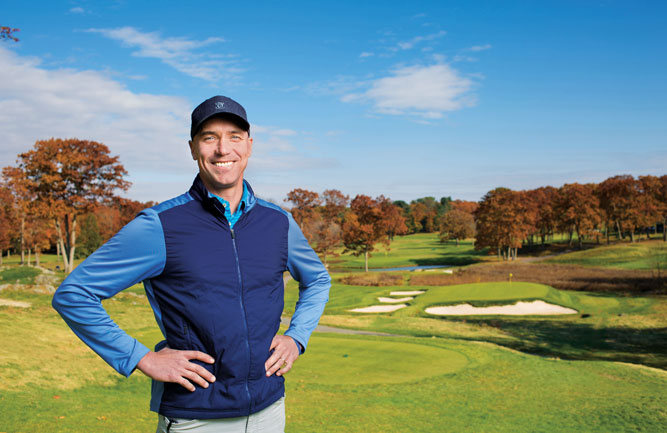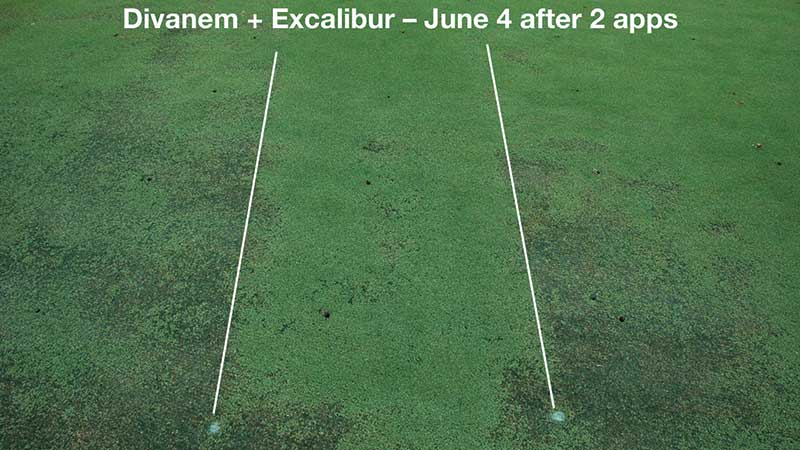Annual bluegrass weevil sampling methods
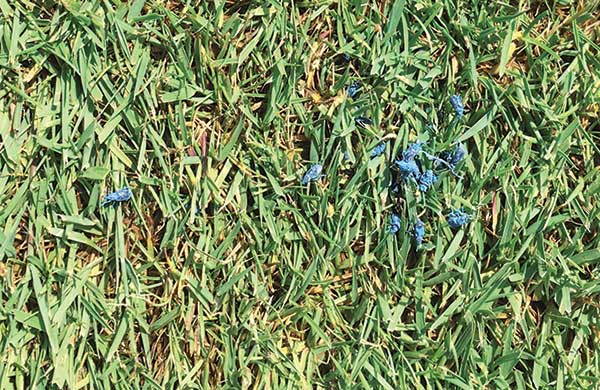
Color-marked annual bluegrass weevil (ABW) adults released into a fairway-height creeping bentgrass plot. (Photo: Albrecht Koppenhofer)
The annual bluegrass weevil (ABW) is a challenging insect pest to control on golf course fairways and greens in eastern North America. Golf course superintendents have relied on insecticides for ABW management, but increased use has led to widespread resistance to several classes of insecticide.
We are concerned that the overuse of the remaining effective insecticides will desensitize ABWs to these compounds as well. Golf course superintendents need to delay resistance development by applying control products only when and where necessary. That requires monitoring and sampling methods that are easy enough to use and fit into their busy schedules.
The sampling techniques for adult and larval stages of ABWs have high predictive power. Our goal for this research is to optimize the use and predictive power of existing sampling and monitoring methods for ABW adults. We looked at the effect of temperature and mowing height on the percentage of adults detected (1) by examining mower clippings, (2) by vacuuming with a leaf blower and (3) by soap flushing. We also determined the effect of water volume applied and detergent concentration on the extraction efficiency of the soap-flushing method.
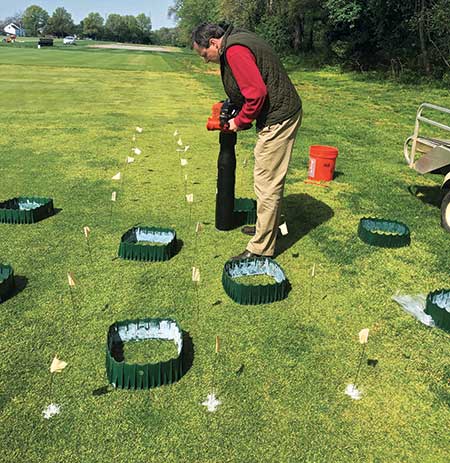
Vacuuming of ABW adults with a leaf blower next to plots from which adults were extracted with soap flushes within 1-square-foot sampling squares. (Photo: Albrecht Koppenhofer)
Temperature and mowing height can influence the efficiency of these methods, particularly for vacuuming and clipping examination. The soap flushes are the least likely to be affected by environmental conditions and mowing height. Water mixed with liquid dishwashing detergent irritates the adults and brings them up to the surface on grass blades for counting. For soap flushing, researchers have not examined the effect of water volume and detergent concentration on extraction efficiency.
In the first year of the study, sampling methods were examined under warm conditions to allow for the optimization of extraction methods. Color-marked adults were released into turf plots about one hour before extractions started. This procedure allowed the adults to settle in and distribute naturally (Figure 1). In lab observations, we found that the colored powder adhered for several days to the adults without interfering with their behavior.
In all experiments, we tested adult recovery in areas consisting of mixed stands of annual bluegrass and creeping bentgrass mown at fairway (0.35 inch) and green (0.118 inch) cutting heights. After the plots were either mowed or vacuumed, we extracted adult ABWs from the plots with soap flushes (Figure 2). We distributed 16 ounces of water with 0.4 percent lemon-scented liquid dishwashing detergent within a 1-square-foot sampling area at zero and five minutes. We counted adults for 20 minutes after the soap flush application.
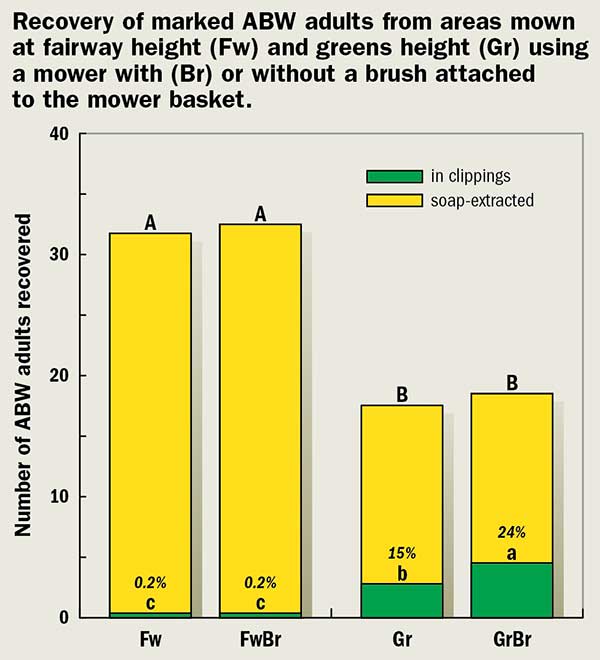
Figure 3 Recovery of marked ABW adult from areas mown at fairway height (Fw) and greens height (Gr) using a mower with (Br) or without a brush attached to the mower basket. Letters indicate significant differences between the number of adults recovered from mower clippings alone (lower case) and for clippings plus the ensuing soap extraction combined (upper case). Percentages within the bars are for clippings relative to total recovery. (Graph: Albrecht Koppenhofer)
Recovery of adults in mower clippings from a Toro Flex 21-inch mower was significantly affected by cutting height. Adult recovery in the fairway was sporadic, and we recovered considerably more adults from the green (Figure 3). However, the total adult recovery from clippings and soap extraction combined was about twice as high from the fairway as from the green.
Adults dispersed more quickly from the release area on the green, and some may have left the sampling area before sampling started. Relative to the total recovery, recovery from the clippings was only 0.2 percent from the green irrespective of attachment of a brush in front of the mower basket. At fairway height, we recovered significantly more adults with the brush (24 percent of total recovery) than without the brush (15 percent).
Recovery of adults by vacuuming was also significantly affected by mowing height. Adult recovery did not differ significantly between the treatments with one or two passages with the vacuum, but more adults were recovered from the green than the fairway (Figure 4). As in the mowing experiment, we recovered about half as many adults in total (including soap extraction) from the green as from the fairway. This trend occurred whether or not we vacuumed the plot area before soap extraction.
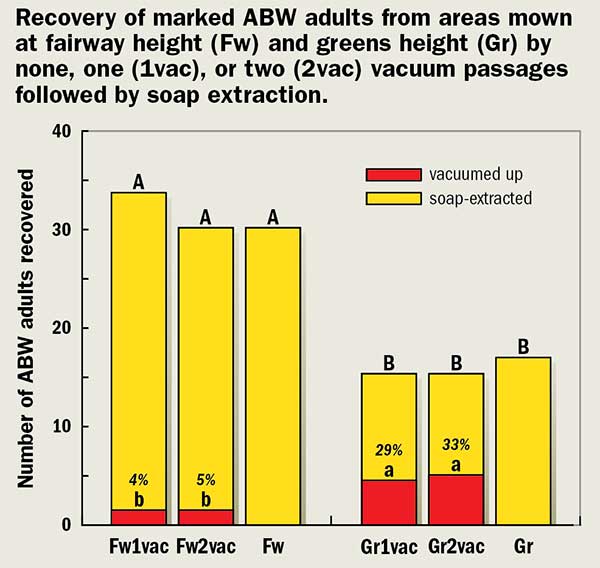
Recovery of marked ABW adults from areas mown at fairway height (Fw) and greens height (Gr) by none, one (1vac) or two (2vac) vacuum passages followed by soap extraction. Letters indicate significant differences between the number of adults recovered by one or two vacuum passages (lower case) and by vacuuming and ensuing soap extraction combined (upper case). Percentages within the bars are for vacuum alone relative to total recovery. (Graph: Albrecht Koppenhofer)
Soap flushing alone was the most effective recovery method. We recovered 83 percent of adults from the fairway but only 42 percent from the green. Again, this result was likely because of the faster dispersal of the adults out of the sampling area on the green. Relative to the total recovery, recovery by vacuuming was 4.5 percent from the fairway and 31 percent from the green.
In additional experiments using natural ABW populations in an area mown at fairway height, we tested the effect of liquid detergent concentration, water volume and application frequency on the extraction of adult ABW in 1-square-foot plots. Extraction efficiency increased with detergent concentration, being higher at 0.8 percent than at 0.4 and 0.2 percent (Figure 5).
At 0.4 percent, two applications extracted significantly more adults than one application. And, one application at 0.4 percent extracted more adults when applying 32 ounces rather than the 16-ounce application.
The data did not show a significant improvement in the split application of 32 ounces at 0.4 percent compared to all applied at once. Yet, it was impossible to use 32 ounces at once without significant runoff of the solution even when applied very slowly.
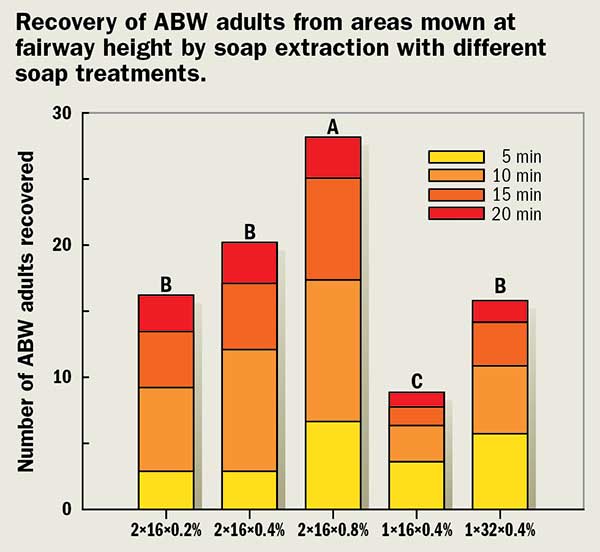
Recovery of ABW adults from areas mown at fairway height by soap extraction with different soap treatments. The solution was applied once (1: at zero minutes) or twice (2: at zero and five minutes), in a volume of 16 or 32 ounces and at a detergent concentration of 0.2, 0.4 and 0.8 percent. Stacked bars show how many adults were recovered at zero to five, five to 10, 10 to 15 and 15 to 20 minutes. Bars with the same letters do not differ significantly in total recovery. (Graph: Albrecht Koppenhofer)
We did not observe any phytotoxicity or significant ABW adult mortality as long as we watered the plots with a similar amount of water after extraction. Higher detergent concentrations maybe even more effective but also more likely to cause phytotoxicity.
Overall, the data suggest that two applications of 16 ounces at 0.8 percent liquid detergent concentration worked the best, and collecting adults for at least 15 or 20 minutes yields better results.
Ongoing research suggests that adult recovery in mower clippings on greens may increase with temperature, but this needs to be confirmed in additional experiments.
Research takeaways
- Adult ABW recovery in mower clippings from the putting green was 15 percent without and 24 percent with a brush attached in front of the mower.
- Mower clippings from a fairway only recovered 0.2 percent of ABW adults.
- Vacuuming with a leaf blower recovered only 4.5 percent of adults from a fairway but 31 percent from a green.
- Soap flushing with 16 fluid ounces of water containing 0.4 percent liquid dishwashing detergent applied twice recovered 83 percent of adults from a fairway within 20 minutes.
- Soap flushing was most effective with 16 ounces of water containing 0.8 percent dishwashing detergents applied twice and with adults collected for 20 minutes.
Albrecht Koppenhöfer, Ph.D., is an Extension Specialist in entomology at Rutgers University, New Brunswick, N.J. You can contact him at a.koppenhofer@rutgers.edu. Sousa, Ph.D., and Geisert, Ph.D., are postdoctoral researchers in Koppenhöfer’s program.









